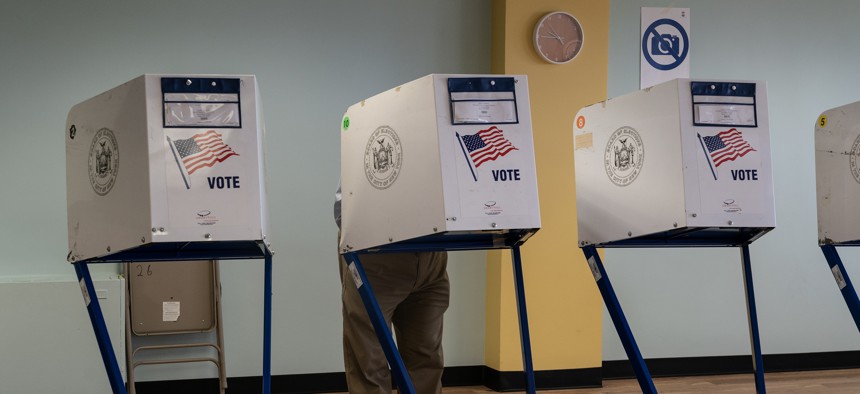Opinion
Opinion: Tomorrow is election day in New York City – but it shouldn’t be
Moving local elections to even-numbered years to coincide with state and federal races would dramatically increase voter turnout.

People vote at a polling station in the Bronx on Nov. 8, 2022. Lev Radin/Pacific Press/LightRocket via Getty Images
Tomorrow is election day in New York City, but only a handful of voters are expected to show up at the polls. It’s a problem. And it doesn’t have to be.
New York City’s municipal elections, which are held in odd-numbered years, consistently draw half the number of people who show up to vote for president or governor in even-numbered years. Turnout in the 2021 mayoral general election was a paltry 23%. But that looks sky-high when compared with the abysmal 6.5% turnout in the City Council primary elections this past June.
In the 2022 midterm election, when gubernatorial and congressional races were on the ballot, 38% of New York City voters showed up to vote. In the 2020 presidential election, turnout was even higher – 62%.
Higher voter turnout isn’t just a good government ideal; it impacts who has a voice in local politics, and who ends up being elected. The effects of low voter turnout are not evenly distributed. Studies have shown that young voters and those who live in majority-minority districts are less likely to cast a vote in off-year elections, which means that the people choosing our local elected officials tend to be whiter and older, and generally less representative of our city’s diversity.
Some argue that moving municipal races to even years will decrease the attention given to local issues. But the opposite is likely true. Assembly races in even-numbered years had higher turnouts than Council races held in odd-numbered years, suggesting that down-ticket races get more attention when they appear on the same ballot as more prominent contests. Local political consultants have bemoaned the lengthier ballot that consolidated elections require and cited fears that mixing ranked-choice voting (for municipal elections) and regular voting (for state and federal races) on the same ballot would confuse voters. However, it is hard to shake the feeling that their real concern is missing out on the off-year business that keeps them consistently employed.
Scholars have found no difference in the amount of media attention devoted to school board races in “on- versus off-cycle” election contexts. There are proven ways to increase attention to local races and decrease the number of voters who skip those on when casting their ballots. In Los Angeles, for example, ballots list local races first, which discourages ballot drop-off. Ultimately, it is hard to argue that more people voting in a democratically run election is a bad thing.
Voting in multiple races on one ballot consolidates the work for voters and limits the number of times they need to read voter guides and research candidates. As a bonus, holding municipal elections in even numbered years would also decrease election administration costs.
Change is hard, and it is rare that elected officials are willing to change the rules of the system which got them elected in the first place. But there are signs that New York may be inching closer to moving municipal elections to even years. Citizens Union recently released a report touting the benefits of even-year municipal election contests, and the city Campaign Finance Board issued a recommendation that municipal elections be aligned with even-year races. This year, the New York state Senate and Assembly both passed legislation that moves county-level elections to even years. The bills passed with overwhelming majorities in both houses and now await Gov. Kathy Hochul’s signature.
Moving New York City elections to even years, however, would require more than simply passing legislation in Albany. It would require an amendment to the state’s constitution. The city Campaign Finance Board has helpfully detailed the potential paths to an on-cycle election schedule, and now we need our lawmakers to consider which path will work best for New York voters. It is not a quick or easy process, but it is a worthy one. The potential paths all lead to the same outcomes: higher voter participation rates, decreased election administration costs and an electorate that is more reflective of the demographics of our city.
Laura Tamman is an Adjunct Assistant Professor of Urban Policy and Planning at Hunter College.
NEXT STORY: Opinion: The PLAN Act promotes fairness for formerly incarcerated people

